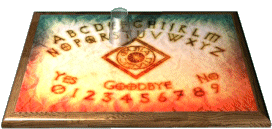THE OUIJA BOARD
|
Ouija is the belief that one can receive messages during a seance by the Ouija board (also called talking board, spirit board) and planchette. The fingers of the participants are placed on the planchette which then moves about a board covered with numbers, letters and symbols so as to spell out messages. According to some sources, the first historical mention of something resembling a Ouija board is found in China around 1200 BC, a divination method known as Fu Ji (扶乩). Other sources claim that according to a French historical account of the philosopher Pythagoras, in 540BC his sect would conduct seances at "a mystic table, moving on wheels, moved towards signs, which the philosopher and his pupil, Philolaus, interpreted to the audience as being revelations supposedly from an unseen world." However, other sources call both claims into dispute, claiming that Fu Ji is spirit writing, not the use of a spirit board, and that there is no record of Pythagoras or his students actually having used this method of achieving oracles or divinations. In addition, the claim of ancient Greek use is called into doubt by questions of historical accuracy, as Philolaus was never the pupil of Pythagoras, and indeed was born roughly twenty-five years after Pythagoras's death. The first undisputed use of the talking boards came with the Spriritualism movement in the US in the mid-19th century. Methods of divination at that time used various ways to spell out messages, including swinging a pendulum over a plate that had letters around the edge or using an entire table to indicate letters drawn on the floor. Often used was a small wooden tablet supported on casters. This tablet, called a planchette, was affixed with a pencil that would write out messages in a fashion similar to automatic writing. These methods may predate modern Spiritualism. During the late 1800s, planchettes were widely sold as a novelty. The businessmen Elijah Bond and Charles Kennard had the idea to patent a planchette sold with a board on which the alphabet was printed. The patantees filed on May 28, 1890 for patent protection and thus had invented the first Ouija board. Issue date on the patent was February 10, 1891. They recieved US patent 446054. Bond was an attorney and was an inventor of other objects in addition to this device. An employee of Kennard, William Fuld took over the talking board production and in 1901, he started production of his own boards under the name "Ouija" *. The Fuld name would become synonymous with the Ouija board, as Fuld reinvented its history, claiming that he himself had invented it. Countless talking boards from Fuld's competitors flooded the market and all these boards enjoyed a heyday from the 1920s through the 1960s. Fuld sued many companies over the "Ouija" name and concept right up until his death in 1927. In 1966, Fuld's estate sold the entire business to Parker Brothers, who continues to hold all trademarks and patents. About 10 brands of talking boards are sold today under various names.
|
![]() Copyright(C) 2007
- 2020. All rights reserved.
Copyright(C) 2007
- 2020. All rights reserved.
